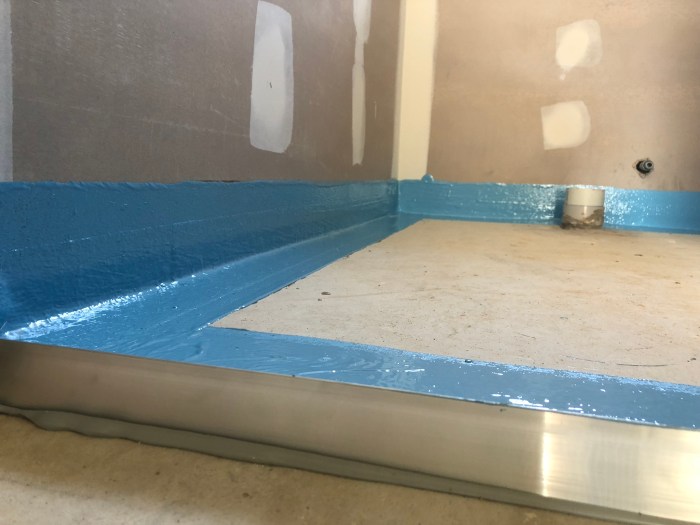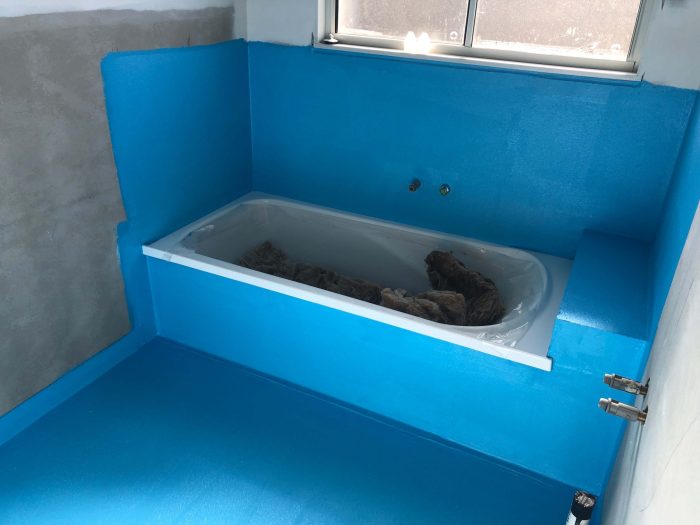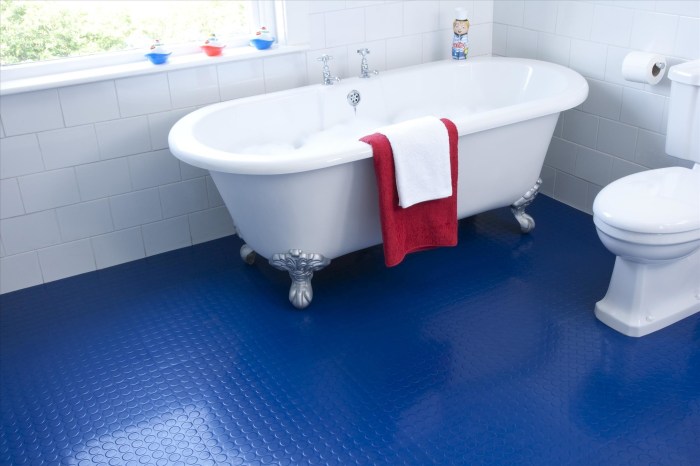Creating a waterproof bathroom floor is essential for maintaining a safe, clean, and healthy bathroom environment. Water damage can lead to mold growth, rot, and structural issues, making it crucial to implement effective waterproofing solutions.
This guide will delve into the various waterproofing materials, techniques, and design considerations for bathroom floors. We will also provide step-by-step installation procedures, maintenance tips, and case studies to help you achieve a waterproof bathroom floor that will last for years to come.
Waterproofing Materials and Techniques
To effectively waterproof bathroom floors, a variety of materials and techniques are employed. Each material possesses unique advantages and drawbacks, and their selection depends on factors such as the type of substrate, the level of moisture exposure, and the desired aesthetics.
Membranes
- Liquid-applied membranes: These are liquid coatings that cure to form a seamless, flexible membrane. They are easy to apply and can conform to irregular surfaces. However, they require proper surface preparation and can be more expensive than other options.
- Sheet membranes: Made from materials like vinyl or rubber, sheet membranes are installed in sheets or rolls. They provide excellent waterproofing but can be more difficult to install and may require additional adhesives or fasteners.
Sealants
- Silicone sealants: These are commonly used around fixtures, penetrations, and joints. They are flexible and resistant to mold and mildew, but they can be difficult to apply and may not adhere well to all surfaces.
- Polyurethane sealants: These offer superior adhesion and durability compared to silicone sealants. They are often used in high-traffic areas or where heavy water exposure is expected.
Coatings
- Cementitious coatings: These are made from cement-based materials and provide a hard, durable finish. They are suitable for use on concrete substrates but may require multiple coats for adequate waterproofing.
- Epoxy coatings: These are highly resistant to chemicals and moisture. They are often used in commercial applications or areas with heavy foot traffic, but they can be more expensive and require professional installation.
Installation Procedures
Installing waterproofing solutions for bathroom floors involves a step-by-step process that requires careful attention to detail. Proper installation ensures the effectiveness of the waterproofing system and prevents water damage to the subfloor and surrounding structures.
Membrane Application
Membrane application involves laying down a waterproof barrier over the bathroom floor. This can be done using various materials, such as rubber, vinyl, or plastic sheeting.
- Clean and prepare the floor surface by removing any debris or dirt.
- Apply a primer to the floor to improve the adhesion of the membrane.
- Roll out the membrane over the floor, ensuring it covers the entire area, including corners and edges.
- Overlap the membrane strips by at least 6 inches and seal the seams using waterproof tape.
- Secure the membrane to the floor using nails or screws along the edges.
Common mistakes to avoid:
- Not overlapping the membrane strips sufficiently.
- Not sealing the seams properly.
- Puncturing the membrane during installation.
Sealant Placement
Sealants are used to fill gaps and seal joints between the membrane and other bathroom fixtures, such as the shower base or toilet flange. This prevents water from seeping through these areas.
- Apply a bead of sealant around the perimeter of the shower base or toilet flange.
- Smooth out the sealant using a wet finger or a sealant tool.
- Allow the sealant to cure according to the manufacturer’s instructions.
Common mistakes to avoid:
- Applying the sealant too thinly.
- Not smoothing out the sealant properly.
- Using the wrong type of sealant for the application.
Coating Application
Coatings are applied over the membrane to provide an additional layer of protection against water. These coatings can be made of various materials, such as epoxy, polyurethane, or acrylic.
- Apply the coating evenly over the membrane using a brush or roller.
- Allow the coating to dry completely before using the bathroom.
Common mistakes to avoid:
- Applying the coating too thinly.
- Not allowing the coating to dry completely before using the bathroom.
- Using the wrong type of coating for the application.
Maintenance and Repair
Maintaining waterproofing systems is crucial to ensure their longevity and effectiveness. Regular inspections and timely repairs prevent minor issues from escalating into costly problems.
Inspections:
- Check for visible signs of damage, such as cracks, blisters, or peeling.
- Inspect joints and seams for any gaps or leaks.
- Monitor for any changes in moisture levels or water stains.
Repairs:
- Address any leaks promptly to prevent further water penetration.
- Repair cracks or damaged areas with appropriate waterproofing materials.
- Re-seal joints and seams as needed to maintain watertightness.
Consequences of Neglecting Maintenance:
- Water damage to underlying structures and finishes.
- Mold and mildew growth, leading to health concerns.
- Structural weakening, compromising the integrity of the bathroom.
- Increased repair costs and premature replacement of the waterproofing system.
Case Studies and Best Practices
Explore successful bathroom floor waterproofing projects, showcasing best practices and lessons learned. Delve into industry standards and regulations to ensure optimal results.
Case Study: Luxurious Master Bathroom
In a sprawling master bathroom, a combination of liquid membrane and tile backer board was employed to create a waterproof barrier. The liquid membrane provided a seamless seal, while the tile backer board added structural support and ensured a level surface for tile installation.
Industry Standards and Regulations
Adherence to industry standards and regulations is crucial for effective bathroom floor waterproofing. The International Code Council (ICC) provides guidelines for waterproofing materials and installation methods, ensuring compliance with building codes and safety standards.
Closure
By understanding the different waterproofing solutions available and following the best practices Artikeld in this guide, you can create a bathroom floor that is both stylish and waterproof. Remember to consider the specific needs of your bathroom, consult with professionals if necessary, and prioritize regular maintenance to ensure a long-lasting and watertight floor.



